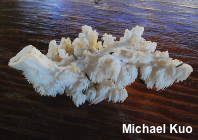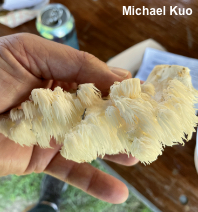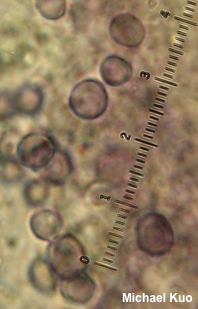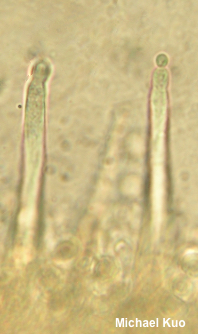| Major Groups > Toothed Mushrooms > Hericium > Hericium americanum |

|
Hericium americanum [ Basidiomycota > Russulales > Hericiaceae > Hericium . . . ] by Michael Kuo Hericium americanum is North America's only Hericium species that combines long spines with a branched fruiting body. It is apparently found only east of the Great Plains, fruiting from deadwood or live trees. Though it is more frequently found on hardwoods, it is occasionally documented on conifers. Hericium coralloides is similar but has shorter spines and smaller spores, while Hericium erinaceus has long spines but is not branched (however, young species of Hericium americanum in which branches have not fully developed might be confused with Hericium erinaceus). An eastern European species, Hericium alpestre, is virtually identical but prefers the wood of conifers. It may be the same as Hericium americanum (the two species have "highly similar morphology and ITS sequences" according to Hallenberg et al. 2013). Description: Ecology: Saprobic and possibly parasitic; growing alone or gregariously; fruiting on dead hardwood logs and stumps, or from the wounds of living hardwoods; also sometimes on the wood of conifers; late summer and fall; originally described from Pennsylvania; widespread in North America east of the Great Plains, especially north of the 38th Parallel (roughly, Interstate 70); also recorded from Central America. Western North American reports online probably represent misidentifications. The illustrated and described collection is from Pennsylvania. Fruiting Body: 15–20 cm across; consisting of a tightly branched structure arising from a rooting base or core; with densely packed spines 0.5–4 cm long hanging from the branches; white, or in age discoloring brownish to yellowish with age. Flesh: White; not changing when sliced. Odor and Taste: Not distinctive. Spore Print: White. Microscopic Features: Spores 5–6.5 µm; globose or very broadly ellipsoid; smooth; hyaline in KOH; strongly amyloid. Basidia 25–28 x 4–5 µm; subclavate; 4-sterigmate. Gloeoplerous hyphae present, sometimes extending into hymenium to become cystidia (up to 85 x 7.5 µm, fusiform with knobbed apices, smooth, thin-walled). REFERENCES: J. H. Ginns, 1984. (Harrison, 1973; Smith, Smith & Weber, 1981; Ginns, 1985; Arora, 1986; Phillips, 1991/2005; Lincoff, 1992; Metzler & Metzler, 1992; Horn, Kay & Abel, 1993; Barron, 1999; McNeil, 2006; Miller & Miller, 2006; Kuo, 2007; Hallenberg et al., 2013; Woehrel & Light, 2017; Elliott & Stephenson, 2018; Sturgeon, 2018; McKnight et al., 2021.) Herb. Kuo 09182109. This site contains no information about the edibility or toxicity of mushrooms. |
© MushroomExpert.Com |
|
Cite this page as: Kuo, M. (2022, July). Hericium americanum. Retrieved from the MushroomExpert.Com Web site: http://www.mushroomexpert.com/hericium_americanum.html |



